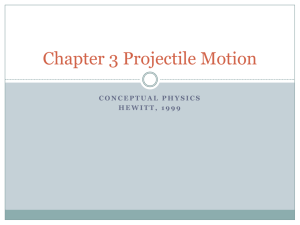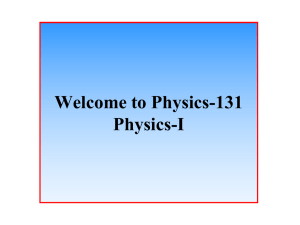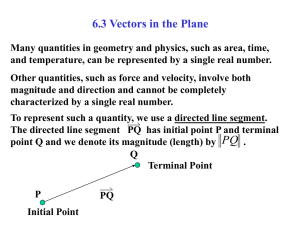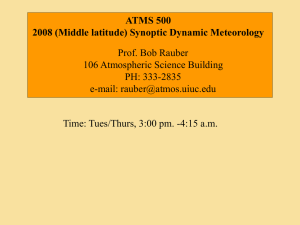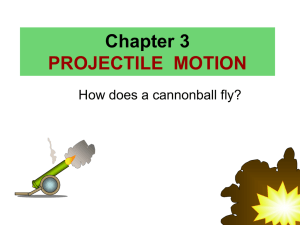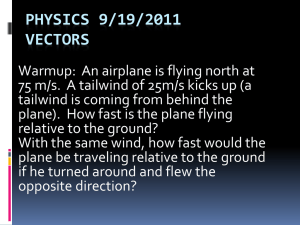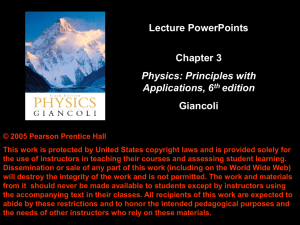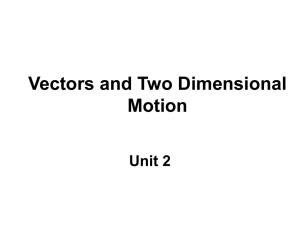Lecture for 1/26
advertisement
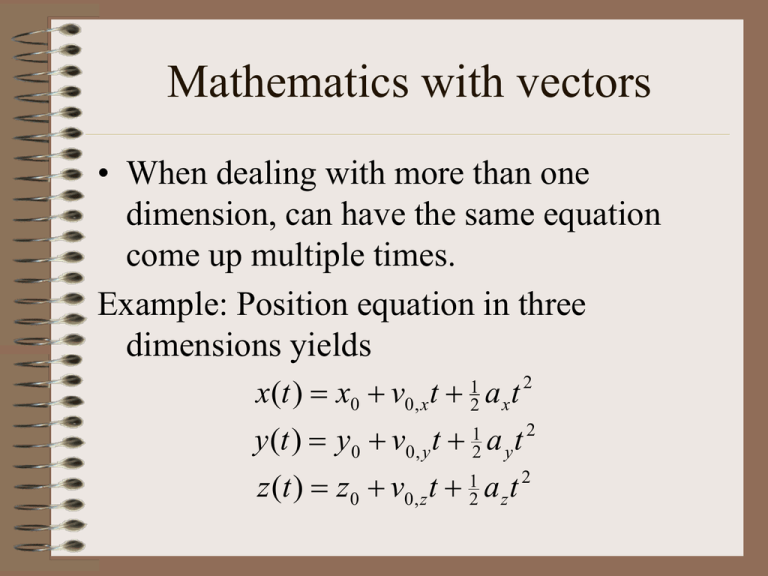
Mathematics with vectors • When dealing with more than one dimension, can have the same equation come up multiple times. Example: Position equation in three dimensions yields x(t ) x0 v0, x t 12 a x t 2 y (t ) y0 v0, y t 12 a y t 2 z (t ) z0 v0, z t 12 a z t 2 • In a situation with multiple objects and multiple physical quantities, the number of equations increases dramatically! – Need a shorthand to simplify the process. – Vectors provide this simplification. • Note that vectors provide a shorthand to see physical relationships, but never allow for numerical answers! Definition of vectors • Vectors are a set of numbers that describe the same physical quantity – Number of numbers equals the number of dimensions Example: Blood pressure – use both systolic and diastolic to determine health • Vectors are physical objects with magnitude and direction Example: Herd migration – number of animals and direction of movement determines migration. Components • Magnitude of vector depicted by length • Direction by angle • Components are projection onto the various axes – Length along axis is magnitude in that direction – One component for each axis Shorthand Notation x t x0 v0t 12 at 2 is shorthand for x x x0 v0, xt axt 1 2 2 y (t ) y0 v0, yt 12 a yt 2 z (t ) z0 v0, zt 12 azt 2 where letter subscripts indicate projection axis Addition/Subtraction • Add and subtract vectors by components – Notice that if B has a component in an opposite direction of A, then components subtract. A B ( Ax Bx ) xˆ ( Ay By ) yˆ •Subtract vectors by reversing direction of subtracted vector and adding –Reverse direction by changing sign on all components. Vector Multiplication • Three types of vector multiplication – scalar x vector = vector – vector x vector = scalar – vector x vector = vector • Scalar (number) x vector simply “stretches” vector – Scalar multiplies each component equally Scalar (Dot) Product • vector x vector = scalar – Product of magnitude of one vector times projected magnitude of other A B A( B cos ) Ax Bx Ay By Vector (Cross) Product • vector x vector = vector – Two (perpendicular) vectors define plane – Direction of product is at right angles to this plane – Magnitude is product of perpendicular vectors A B AB sin Ballistic Motion • Ballistic motion is the most basic motion in two dimensions. – Only acceleration is that of gravity – Only acts in one direction – Motion is in two dimensions As a projectile thrown upward at a non-vertical angle moves in a parabolic path, at what point along its path are the velocity and acceleration vectors for the projectile parallel to each other? 1. 2. 3. 4. at the point just before the projectile lands at the highest point at the launch point nowhere As a projectile thrown upward at a non-vertical angle moves in a parabolic path, at what point along its path are the velocity and acceleration vectors for the projectile parallel to each other? 1. 2. 3. 4. at the point just before the projectile lands at the highest point at the launch point nowhere Solving ballistic motion problems • Treat each direction independently Example: A field biologist is collecting specimens. She spots a rare monkey 10 m up in a tree 35 m away.Moving carefully, she fires a tranquilizer dart at the monkey. Unfortunately, at the moment the trigger is pulled, the monkey lets go. If the dart leaves the gun at 45 m/s, does the dart hit the monkey? 1) Find initial angle Using trigonometry, get tan 0 h d h d 10 m tan 1 35 m 15.95 0 tan 1 2. Find time for dart to travel horizontally to tree Apply position equation to horizontal motion d v0, x t v0 cos 0t d t v0 cos 0 35 m 45 ms cos15.95 0.81 s 3. Find dart’s distance above ground when it reaches tree Use distance equation for vertical motion y v0, y t 12 a y t 2 v0 sin 0t 12 gt 2 (45 m s )sin 15.95 0.81 s 1 2 9.81 0.81 s m s2 6.79 m 4. Find distance of monkey above ground y h 12 a y t 2 (10 m) 12 9.81 6.79 m m s2 0.81 s 2 2 As a projectile thrown upward at a non-vertical angle moves in a parabolic path, at what point along its path are the velocity and acceleration vectors for the projectile perpendicular to each other? 1. at the point midway between the launch point and the highest point 2. at the launch point 3. nowhere 4. at the highest point
